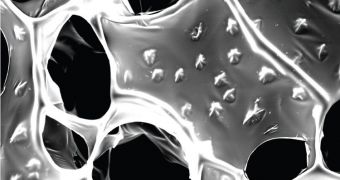Oftentimes, after a person suffers a heart attack, cells in the cardiac muscle lose their ability to fire off electrical impulses in concert. This can have serious side-effects on the heart, but now researchers in the United States say they've found a way to make this type of consequences history.
Investigators at the Massachusetts Institute of Technology (MIT), in Cambridge, say that they were able to create a type of cardiac patch that includes gold nanowires. These tiny structures force cardiac cells to beat at the same time, replacing the damaged natural mechanism that does the same thing.
Together with colleagues at the Children’s Hospital Boston (CHB), the team was also able to produce small pieces of heart tissue that beat in concert. The joint group says that this achievement could be used to promote healing in heart attack patients,.
Details of the investigation were published in the latest issue of the top scientific journal Nature Nanotechnology. “The heart is an electrically quite sophisticated piece of machinery,” research scientist Daniel Kohane explains.
He holds an appointment as a Harvard-MIT Division of Health Sciences and Technology (HST) professor, and is also the senior author of the new paper. “It is important that the cells beat together, or the tissue won’t function properly,” he goes on to say.
The expert reveals that his team was able to improve the performances of existing patches by simply growing cardiac cells in vitro, with gold nanowires scattered across the tissue. Kohane explains that this increases the overall performance of the cardiac path by a wide margin.
Gold wires were introduced into the mix because the miniature scaffolds that are used to separate cells when grown in the lab are not good conductors for electricity. The element, on the other hand, is a very good conductor.
“We started brainstorming, and it occurred to me that it’s actually fairly easy to grow gold nanoconductors, which of course are very conductive. You can grow them to be a couple microns long, which is more than enough to pass through the walls of the scaffold,” Brian Timko says.
The scientist is a postdoctoral researcher at MIT, and also a member of the team. Other members included Tel Aviv University expert Tal Dvir and the MIT David H. Koch Institute professor, Robert Langer.
“It’s very beautiful work. I think the results are quite unambiguous, and very exciting – both in showing fundamentally that they’ve improved the conductivity of these scaffolds, and then how that clearly makes a difference in enhancing the collective firing of the cardiac tissue,” Harvard University chemistry professor Charles Lieber comments.
“I think other people can take advantage of this idea for other systems: In other muscle cells, other vascular constructs, perhaps even in neural systems, this is a simple way to have a big impact on the collective communication of cells. A lot of people are going to be jumping on this,” he concludes.

 14 DAY TRIAL //
14 DAY TRIAL //